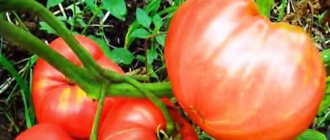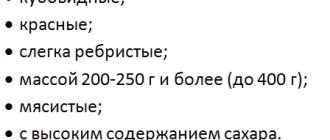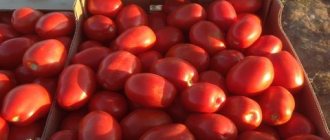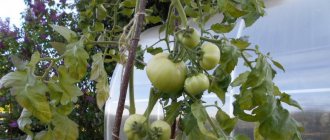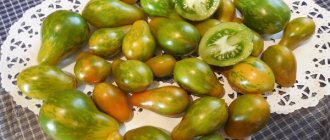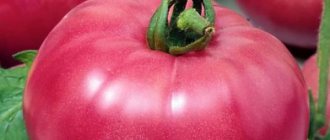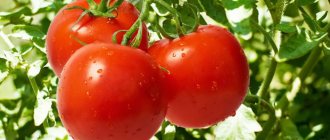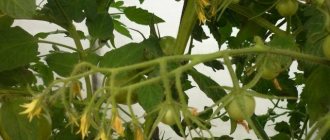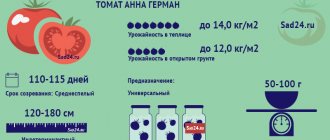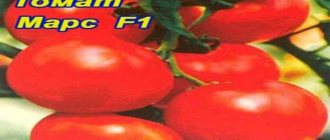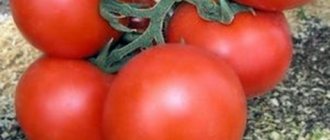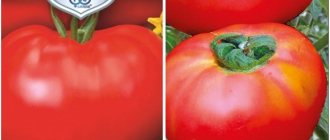To find the best varieties, you need to try planting new things. The productive tomato Lel can become a highlight in any garden bed. A highly productive variety will not leave anyone without a harvest.
| Height | Landing location | Ripening time | Fruit color | Fruit size | Origin | Fruit shape |
| short | Greenhouse, Open ground | Mid-season | Reds | Average | Variety | Plum-shaped or oval |
Description of the variety
Tomato Lel is a mid-early variety with limited stem growth . From germination to fruit ripening it takes from 100 to 122 days. The bushes grow lush, but low (up to 0.5 meters). According to most summer residents, they should not be adopted.
Distinctive features
The determinate variety is ideal for open ground , but is also used for growing in greenhouses. Tolerates both heat and cold well. Grows even with a lack of sunlight.
The leaves of the bushes are green and small in size . The inflorescences are simple. Flowering occurs with the appearance of inflorescences between the 6th and 7th leaves, the subsequent ones appear after 2 leaves.
Late blight is not scary for Lel tomatoes . They are picked before the onset of this disease.
Productivity and characteristics of fruits
The variety is characterized by high productivity . On average, 2 kg of tomatoes are harvested from one small bush. As you can see in the photo, the fruits grow in clusters (5-9 tomatoes on each).
Lel tomatoes are distinguished by their density and smoothness . Their average weight is 60 g, the maximum is 75 g. Tomatoes have an elongated shape with a sharp tip. The color of ripe tomatoes is bright red. The fruits are very juicy, have a sweetish, sour taste and rich aroma.
Read about other tomato varieties:
High-yielding and unpretentious tomato "Benito"
Tomato "Eldorado" and features of its cultivation
Tomato "Dubok": growing instructions from A to Z
What to choose for open ground
Despite the climatic conditions of the region, tomatoes can also be grown in open ground.
Aurora F1
Tomatoes ripen in 85-90 days. The culture is very unpretentious in care and produces a large harvest
The hybrid is characterized by resistance to typical infections. It also has excellent transportability and produces a bountiful harvest.
Alsou
The fruits of these tomatoes ripen quite early. The first tomatoes can be obtained 70 days after planting. Tomatoes can be planted both in the north and south of the region.
This hybrid is characterized by medium-sized bushes. They reach 80 centimeters. To protect the bushes from gusty winds, they should be tied up.
The key difference between the fruits is the ribbed texture. Unripe tomatoes have a green tint and have a spot near the stalk. In ripe tomatoes it disappears and the tomatoes turn red. Ripe vegetables are used for fresh consumption and preservation.
Scarlet candles
This variety is characterized by a pink tint of tomatoes and tall bushes. To reap a good harvest, it is worth forming crops with 2-3 stems. From 1 square meter of planting it is possible to obtain 12 kilograms of fruit. They are characterized by a cylindrical shape and are covered with a thin skin. This variety is characterized by a pronounced sweet taste.
Alpha
This hybrid is recommended to be planted in the Urals. Tomatoes tolerate climate instability and temperature fluctuations well. Alpha has low bushes that grow to a maximum of 40 centimeters.
After some time, the bushes are covered with small leaves resembling potato leaves. The round fruits have a red skin and are slightly flattened at the edges. Alpha is characterized by its small size. The average weight of tomatoes is no more than 50-60 grams.
Berdsky
Tomatoes are planted in Yekaterinburg. They are also often grown in the Perm region. The crop is characterized by large fruits and high productivity. With proper cultivation, the bushes reach 1 meter. The culture requires attachment to a support and formation into two stems.
Round tomatoes are characterized by very large sizes. Their weight is 750-800 grams. Usually the largest specimens are located at the bottom. They are eaten fresh or canned.
Biysk rose
This variety is considered mid-season. Tomato ripening takes 120 days. Plants have spreading branches. Therefore, it is recommended to plant them at intervals. The advantages of tomatoes include excellent taste and large size. The hybrid is considered universal and suitable for the southern or northern region.
Gina
Growing such tomatoes in the Urals is not particularly difficult. The hybrid is characterized by low bushes that are no more than 55 centimeters. However, the plants need to be tied up, since large fruits can break the bush. Plants are immune to verticellosis, root rot and fusarium.
The brushes are decorated with 5-6 fruits. They have a round shape and are slightly flattened on top. The average weight of 1 fruit is 400-500 grams. There is a dense peel on top. There is sweet pulp inside.
Important! The main advantage of the fruit is its long shelf life. If suitable conditions are created, tomatoes will retain their properties for 2 months.
Evgeniya
The variety has small fruits that weigh 80 grams. The main advantages of the plant include excellent taste, resistance to drought and infectious diseases, and early ripening. Ovaries form on tomatoes even in extreme climatic conditions. From 1 square meter of planting it is possible to obtain 7 kilograms of tomatoes.
Golden Queen and Nezhdana
These varieties have a number of similar properties. As the fruits ripen, they acquire a bright yellow color. The weight of tomatoes reaches 500-700 grams. With systematic care and in a favorable climate, it takes 105 days for tomatoes to ripen.
King of Siberia
This variety is chosen by many summer residents. It was received relatively recently. Breeders developed the crop specifically for harsh climates. The plant is characterized by fairly tall bushes that can grow up to 2 meters. The weight of tomatoes is 800 grams. When grown correctly, they can reach 1 kilogram.
Niagara
This is a common plant that is grown in the Trans-Urals. The hybrid is considered indeterminate, since the development of the stem continues throughout the entire growing season. The bushes grow quite strongly. Tomatoes are characterized by their oval shape and weigh 80-100 grams. With adequate care, plants are resistant to infectious diseases and do not suffer from pest attacks.
Growing seedlings
Seedlings are sown 2 months before planting in the ground . The most favorable time for sowing is mid-March.
Due to the cold resistance of the variety, seedlings can be placed both in heated rooms and in greenhouses. However, in this case, sowing should be waited until April, when the soil in the greenhouse has warmed up sufficiently and the temperature at night will not drop below 14 degrees.
Seed preparation
Lel tomato seeds do not require special preparation . It is enough to hold them for some time in a solution of potassium permanganate for disinfection. Next, the seeds are placed in damp gauze for germination.
Note. Before planting, the seeds are sorted, removing empty and small ones. If you cannot clearly determine which seeds are suitable for growing, experts recommend using salt water. In it, bad seeds float to the surface.
Container and soil
Lel tomatoes love space . For this reason, seeds should be sown in deep, spacious containers at a considerable distance from each other.
Important! The bushes of the tomatoes in question, obtained from strong, dense sprouts, give a good harvest. Seedlings should not be allowed to thicken. Otherwise, the sprouts will not have enough nutrients, which will lead to their stretching.
Lel tomatoes are very demanding on soil . If the soil for planting seedlings is chosen incorrectly, they will grow poorly and it will not be possible to obtain sprouts suitable for planting. It is recommended to use special ready-made soil for tomatoes from trusted manufacturers for seedlings.
Sowing
Lel tomatoes should be sown shallow . Each seed is immersed in the ground about half a centimeter. This will allow the root system to develop well.
Before sowing, the soil must be disinfected by spilling it with a solution of potassium permanganate. After sowing, cover the container with film and wait for the first shoots to appear. Then the film is removed.
Growing and care
When growing seedlings, the heat and light conditions should be observed . The optimal temperature is from 25 to 27 degrees. It is better to place the seedlings on the windowsill on the sunny side. If there is not enough light, it is recommended to use LED lamps. Lel tomatoes always peak when the sprouts have 2 leaves.
Before planting in the ground, seedlings are hardened off . The sprouts at this time should have a strong stem and dark green leaves. It is better to remove weak shoots to allow others to develop.
Reference. To harden Lel tomato seedlings, it is enough to open the window during the daytime. In this case, drafts should be avoided.
How to grow seedlings
Summer residents are preparing for the season already in February-March. High-quality seeds and seedlings are the key to a good harvest.
Seed preparation
To prevent disease, seeds are disinfected with potassium permanganate or hydrogen peroxide. A proven method is to soak the seeds for 20 minutes in a 1% solution of potassium permanganate.
Then they need to be saturated with nutrients. To do this, use solutions of potassium or sodium humate, aloe vera juice or potato water. There are also special preparations, for example, “Immunocytophyte”.
All that remains is to harden the seeds. Tomatoes love warmth, and this procedure will help them withstand unexpected temperature changes. Seeds that have sprouted first are left in the refrigerator overnight and then returned to the heat for the day. This needs to be done 2-3 times.
Sowing
It begins 45-55 days before planting seedlings in the ground. Seeds are sown in small containers, common or individual. The soil is prepared from one part peat, one part sawdust and two parts greenhouse soil. The sawdust is first disinfected with boiling water, then steamed with a hot urea solution.
To one bucket of prepared soil add two handfuls of crushed shells, 0.5 liters of ash, 2 tbsp. l. superphosphate. Then mix thoroughly and pour in a hot solution of light-colored manganese. When the earth has cooled, fill the planting containers halfway.
After planting the seeds, the containers are covered with film or glass and left indoors at a temperature of 22-24°C.
When shoots appear, the film is removed and the containers are moved to a more illuminated place. Since the tomato is shade-tolerant, it is not necessary to place the seedlings in a sunny place.
The first watering is 2 tsp. carried out on the fourth day, distributing water along the edge of the nursery. After the formation of the third leaf, 100 ml of water is allocated to each bush.
When two true leaves appear, the seedlings are picked and placed in separate containers. To slow down the overgrowth of seedlings, they are planted again after 21 days.
At the age of seven days, the sprouts are sprayed with Epin to increase immunity. The first fertilizing is carried out 10 days after the first picking with Fertika Lux or Clean Sheet fertilizer.
Two weeks before transplanting, the seedlings begin to harden. To do this, they are taken outside for 2-3 hours, and the night temperature in the room where the seedlings are located is reduced to 14°C. Gradually, the time the sprouts stay outside increases to 18 hours.
How to grow tomatoes
In order for the Lel tomato to please its owners with a good harvest , basic agrotechnical techniques for growing the crop should be followed. Tomatoes require regular watering, removal of weeds and fertilizing. An important factor is the correct soil selection.
Landing
Lel tomatoes require space. The reason lies in the rather voluminous foliage of the plants in question. It is recommended to plant no more than 5 bushes per square meter .
They are placed at a distance of 40 cm from each other . The optimal distance between the beds is 60 cm. When these values are taken into account, the plant will grow in conditions of normal shade, receive enough light and be ventilated.
Rules of care
Proper soil is very important for Lel tomatoes .
From it the plant should receive all the elements necessary for growth and good productivity. Regular feeding is required - once a week. In addition to organic fertilizers, an actively fruiting plant requires fertilizing with microelements. Normal setting is guaranteed when using fertilizers containing iron, boron, manganese and zinc . It is recommended to apply up to two liters of a solution of complex fertilizers for tomatoes under each bush.
The plant should be watered abundantly . However, oversaturation with moisture is fraught with crop loss. Tomato Lel loves dry air and moist soil in which moisture will not stagnate. Excessive accumulation of moisture often leads to the development of late blight.
Water the plant at the root . Avoid getting moisture on the stem and leaves. The optimal time for watering is morning or evening. It is recommended to use warm water.
The plant needs a lot of nutrients . If there are “neighbors” in the form of weeds, they must be weeded so that the nutrients do not escape from the tomatoes.
Important! To provide air circulation to tomato roots and prevent water stagnation, mulching is required. A layer of dry grass at the top of the soil also prevents weeds from appearing.
There is no need to tie up the plant during the growth period . During the fruiting period, this procedure is recommended, since the fruits grow in massive clusters, under the weight of which the branches can break.
Features of cultivation and possible difficulties
If basic agrotechnical practices are followed, the Lel tomato grows quickly and produces a good harvest . There are no particular difficulties in growing this variety. The main thing is to use high-quality soil, fertilize it in time, and also water the plants correctly and place them in a part of the site that is well-lit by the sun and protected from drafts.
Diseases and pests
Tomato diseases can significantly reduce yield .
Being exposed to them, the plant can no longer grow normally, and therefore, bear fruit. Moreover, it becomes contagious to its fellows. The main diseases of most tomatoes, including the Lel variety, are late blight and cladosporiosis . It is easier to prevent them than to cure them. For prevention, it is recommended to use ready-made store-bought formulations, as well as self-prepared mixtures. Experienced gardeners treat tomato plants with the following solution: 1 liter of water, 5 drops of iodine and a glass of milk. Each tomato bush is generously sprayed with this mixture.
To treat plants already affected by the disease, it is recommended to use special ready-made mixtures for treatment.
Reference. The Lel variety is resistant to the tobacco mosaic virus.
The main pests that attack the variety in question are the Colorado potato beetle and aphids . To destroy them, special chemicals are used that are sprayed on the bushes. When fighting the Colorado potato beetle, it is recommended to use the drugs “Prestige”, “Mospilan” and others. Large beetles are collected from bushes and destroyed.
Aphids are destroyed using solutions of karbofos, bleach or trichlorometaphos . Having prepared the solution according to the instructions on the package, spray it with a spray bottle on the outside of the leaves.
More about tomatoes:
Tomato "Budenovka", giving a bountiful harvest
Tomato "De Barao" and the secrets of its cultivation
Features of cultivation
The Lel variety tomato is of southern origin and loves warm ambient temperatures - above 20 degrees. Requires bright all-round lighting and air dryness of no more than 70%. With the right parameters, tomatoes achieve high yields. Juicy, aromatic fruits delight with their taste not only in summer, but also in winter.
This tomato will delight you in summer and winter
Sowing
Tomato Peter 1: characteristics and description of the variety
Sowing of seeds begins 50-60 days before planting in the ground.
Important! Plant seeds in deep containers to prevent degradation of the root system.
Usually seedlings begin to be prepared in March. Before sowing, it is recommended to soak the seeds in a solution of potassium permanganate and rinse with water. The seeds are immersed 2-3 cm in the soil, moistened with water and placed in a place at room temperature. The planted seeds are covered with film to form condensation and maintain humidity. Like all seeds, Lel seeds are hardened. A change from warm to cold temperature reveals weak shoots that will not bear fruit in the future. Such sprouts must be removed. After the hardening test, only fruit-bearing plants remain.
Dive
After two months, the plant is ready for picking. At this time, it already has two true leaves. A third of the root is carefully cut off for a young plant. In the future, it will acquire a broken root system, which will make it easier to obtain moisture and fertilizers from the soil.
Soil preparation
The soil is pre-prepared for planting seedlings in it. The soil is dug up and loosened. Land for planting needs high-quality fertilizer. Ash, bird droppings and ammonium sulfate are added to the soil. The soil temperature should be at least 10 degrees, and the air temperature should be more than 20 degrees. Lel tomatoes will grow better if their predecessors in the garden were cucumbers.
Fertilization with wood ash
Additionally, they note that tomatoes grow better when they are next to strawberries.
Planting in a garden bed
High-quality seedlings, ready for transplanting, have a thick stem. The landing time is in May. The seedlings are planted loosely in the garden bed. Spreading foliage of neighboring bushes will interfere with the growth and development of fruits. The approximate planting density is up to 5 bushes per 1 sq.m. About 40 cm is left between the bushes to achieve acceptable shading and ventilation.
Care during growth
After planting the plants, they need moderate watering with warm water, fertilizing with minerals, treating insects and removing weeds. Tomato variety Lel prefers dry air and moist soil.
When watering, water should not fall on the leaves of the plant; water should be poured strictly under the root. It is better to water in the evening. During the flowering period, watering is increased. Without enough moisture, the bush will overheat and may drop its flowers. This will lead to the fruit not setting. Over-watered tomatoes run the risk of suffering from late blight.
Late blight of tomato
Iron, zinc, and manganese are used as fertilizers. To make feeding easier, ready-made mixtures of these substances are used. Minerals are involved in the proper formation of the ovary and ensure a rich harvest. Tomato needs weekly feeding. During the flowering period, the frequency of feeding is increased to 2-3 times a week.
Advice. Watering the ovary with a solution of potassium permanganate during the flowering period will benefit the plant. The fruits will grow juicy and aromatic.
The soil under the bushes needs regular loosening. The beds are freed from weeds, which take moisture and fertilizers for themselves.
During active growth, tomatoes must be tied up. Otherwise, the branches will bend towards the ground under the weight of the fruit. The developing bush actively branches, side branches appear - stepchildren. They need to be removed.
With proper care, you can enjoy the delicious taste of tomatoes after 90 days from the date of planting.
The nuances of growing in open ground and in a greenhouse
Growing the variety in question in greenhouse conditions is practically no different from growing it in open ground.
The only thing is that plants can be planted in a greenhouse 1-2 weeks earlier, since here the soil warms up faster. The method of growing them does not affect the taste of tomatoes. Both greenhouse fruits and those grown in the garden have an excellent taste.
There is an opinion that fruits obtained in greenhouse conditions are slightly larger. For this reason, greenhouse tomatoes must be tied up.
Characteristics of tomatoes and varieties
Tomato bushes are indeterminate and profusely tall. The formation of the bush occurs in 1 stem, while all stepsons are removed. The level of foliage coverage is average. The bush reaches an average height of 200 cm. If the plant is located in an open area, its height can be up to 150 cm.
Mathias is a mid-early variety, so you need to wait for the first harvest in about 3.5-4 months. The productivity of tomato is quite high, since per 1 sq. m. accounts for an average of 15 kg of tomatoes, which provides one of the leading positions in terms of productivity.
Tomato fruits have a flat-round shape with a ribbed surface and are red in color. A dozen weight of a ripe tomato is 180 grams, especially large fruits can reach 300 grams. The tomato tastes particularly sweet, with juicy, dense flesh. In cross-section, the grain has five cells with seeds. A ripe tomato does not have a greenish spot near the stalk. The fruits can be processed into tomato paste or juices. In turn, they are suitable for preparing summer salads and pickling.
Harvesting and application
The first fruits of Lel tomatoes ripen 3.5-4 months after planting the seeds . Ripening of fruits is possible even after they are picked from the bush, but fruits ripened on the bush are more aromatic and tastier. This variety of tomatoes is known for its pleasant taste and good keeping quality. It is stored for a long time and is easily transported, maintaining its presentation.
The fruits of the variety can be called universal . They are consumed fresh, canned, and also processed into tomato products. The juice contains about 4% dry matter, 1.8% sugar, as well as a large amount of vitamins and nutrients.
Lel - variety of tomato plant
Information about the admission of Tomato Lel from the Register of the State Variety Commission of the Russian Federation
Application for admission No. 30964, registered 1997-12-26. The Tomato Lel variety was included in the register of approved varieties in 2000. Approved for use in the regions: Central, Central Black Earth.
The originators of the Tomato Lel variety are:
- LLC `AGROFIRMA AELITA` (129343, MOSCOW, NANSEN TRADE, 1)
- TRANSDNISTRIAN Agricultural Research Institute (3300, REPUBLIC OF MOLDOVA, TIRASPOL, MIRA STREET, 50)
Other varieties of tomato plant
Advantages and disadvantages of the variety
Positive qualities of Lel tomatoes:
- high productivity;
- good taste;
- ease of care;
- resistance to adverse weather conditions;
- external attractiveness of fruits;
- resistance to some tomato diseases;
- long shelf life;
- good transportability.
Numerous reviews from gardeners indicate that Lel tomatoes have no negative qualities.
Description of the early variety Lel and its characteristics
A good vegetable grower is not afraid to try new tomato varieties. But the tomato season is not always conducive to experimentation. Which variety should you choose so as not to leave your family without a harvest? Tomato Lel is an unpretentious specimen for growing in open ground and greenhouses.
Characteristics of the variety
The Lel variety belongs to the determinate, low-growing type of tomatoes. The bush is spreading and up to 50 cm high. This allows you to do without pinching, which simplifies caring for the bush. The first brush is laid above the 6th leaf, all subsequent ones every 1-2 leaves, ensuring good yield.
The Lel tomato variety is considered mid-season; ripening begins 120 days after germination. It is distinguished by abundant fruiting - during the ripening period, tomatoes hang on the bush in clusters of 7-9 pieces. From one bush you can harvest about 2 kg of crop. So 10 Lel tomato bushes are enough for both canning and feeding your loved ones with fresh tomatoes.
The dense fruits of the Lel tomato reach an average weight of 60 grams. The shape of the tomatoes is an elongated cream with a sharp tip, the color is classic red. Their small size allows them to be used for home canning and pickles.
Few seeds and juicy fruits are characterized by a beautiful presentation and do not wrinkle during transportation. Taste qualities are at the highest level.
The ratio of dry matter and sugar in the Lel tomato allows it to be used for processing into juice.
Preparing seedlings
You need to take care of sowing Lel tomato seeds for seedlings in mid-March. The variety's resistance to unfavorable climatic conditions allows for sowing seedlings to use not only heated rooms, but also the simplest greenhouse.
When using an unheated greenhouse, it is better to postpone sowing seeds until early April, when the soil under the film covering has warmed up to an acceptable temperature. Before sowing under film, observe for several days that the temperature at night does not drop below 14 degrees.
Seedlings are planted in open ground from the first ten days of May. Good seedlings have thick stems and dark green leaves.
When growing seedlings, you need to avoid the following basic mistakes:
- thickening of crops - leads to stretching of seedlings and their insufficient nutrition;
- non-compliance with temperature and light conditions;
- using unprepared or poor-quality soil;
- the use of small containers for seedlings provokes degradation of the root system;
- ignoring the hardening of seedlings before planting in open ground.
Nutrition
The Lel variety has abundant fruiting, so fertilizing should be done regularly. These should be not only simple organic fertilizers, but also containing microelements.
For the normal formation of ovaries, more than 20 microelements are needed, including boron, iron, zinc, manganese and others. Therefore, it is easier to use ready-made packaged complex fertilizers for tomatoes, which have all the necessary components balanced.
The most effective feeding is during the formation of the ovary - in mid-summer. At this time, feeding is planned at least once a week. Up to 2 liters of ready-made fertilizer solution should be applied under the bush.
Watering
When watering Lel tomatoes, the principle that works best is not to overdo it. The best environment for growing tomatoes is dry air and moist soil. Excess moisture balance leads to the development of various diseases, especially late blight. It is better to water in the first half of the day or in the evening, avoiding water getting on the leaves and stem.
Regular watering is necessary especially during the flowering stage. This saves the plants from overheating, which leads to the shedding of flowers and sterility of pollen. The structure of the Lel tomato bush allows you to successfully use mulching in the beds, which will serve as a good remedy for soil drying out and protection against weeds.
Disease resistance
Diseases are more dangerous to tomatoes than pests because they disrupt the development of the plant. Ground tomatoes are more susceptible to the development of diseases. Sometimes treatment takes place, and in some cases it is necessary to destroy the entire diseased bush.
Late blight and cladosporiosis (brown spot) have become common diseases of tomatoes. Both diseases can be prevented by providing plants with timely care. But proper treatment will also be effective.
And to prevent brown spot, you need to follow the correct watering regime. If it comes to treatment, then all the methods that are used in the fight against late blight will do.
Farmer reviews
On Internet forums for summer residents you can read real reviews from people growing Lel tomatoes. This will help you draw conclusions about how suitable the variety in question is for you.
Anna: “I’ve been planting Lel tomatoes for three years now and every time I fall more and more in love with them. Unpretentious, but at the same time give a high yield. I feed them to the whole family. Everyone loves the taste of them in any form.”
Vitaly: “Last year I planted Lel tomatoes in a greenhouse. In addition to them, there were other varieties. Got sick with late blight. I had to remove several Lelya bushes by the roots. I did not notice their resistance to diseases. The harvest was not impressive. I no longer plant this variety. There is, of course, the possibility that they “didn’t like” something. I didn't bother with the soil. I planted it after the cucumbers.”
Maria: “This variety is one of my favorites. I always plant 15-20 bushes. I have enough for winter salads and for whole pickling. We also happily eat it fresh with the whole family. They imprisoned me for 4 years. There have never been any illnesses."
Characteristics and description of the Shalun tomato variety, its yield
Tomato Shalun is a high-yielding variety with a very tall bush. It is chosen by those gardeners who want to grow as many tomatoes as possible for pickling or making juice or paste. They are also good for sale. They hang on the branches like bunches of grapes. Mid-season tomatoes. And, although they are very hardy, it is still better to plant them in greenhouses.
More about the variety
This variety is resistant to changes in weather conditions. It is easy to care for and resistant to many diseases. A description of the variety will help you figure out how to grow it and how to take care so that the harvest is abundant. And it will be big, since this type of tomato is one of the high-yielding tomato varieties.
The bush is very tall, more than two meters
Its growth is unlimited, so it is always important to ensure that it is tied up with ropes and cut off unnecessary shoots. The foliage does not grow very densely
The fruits hang in clusters on these tomatoes.
The fruits are small and weigh a little, but there are always a lot of them on one cluster. Ripening occurs approximately three months after seed germination. They can be pink or red. The taste is sweet and sour. The subtle aroma of the fruit attracts everyone. There are usually few seeds, the skin is dense. Not prone to cracking. They can be transported over distances and also grown for sale.
Reviews of tomatoes are always positive. This variety is good for salads, slices, and is also ideal for canning. If you are interested in this type of tomato, you need to carefully study how to grow and care for it.
How to grow in northern latitudes
It is better to grow tomatoes in the northern regions by seedlings in greenhouses. There they have the right temperature and protection from external irritants. Seedlings begin to germinate from seeds at the end of winter. The seeds are first soaked in a solution of potassium permanganate, then planted in a container, maintaining distances between each other.
It is better to cover with film until sprouts appear. And when the first leaves appear on the shoots, it will be possible to replant them separately. While growing on the windowsill, you need to provide young plants with good watering, feed them and make sure there is enough light.
These tomatoes love good soil. Fertilizers are placed on the windowsill and in the greenhouse three or four times during the entire growth period. Usually these are potassium and phosphorus fertilizers, peat, chicken droppings, and manure.
Tomato seedlings are planted in a greenhouse strong and hardened. It should have a thick stem and good foliage. When planting, it is necessary to form a bush with one or two stems. This is the only way the tomatoes will bear more fruit.
Good yield of this variety depends on careful care. The more careful a summer resident treats crops, the more abundant and healthy they produce.
Care and control of insects
The characteristics of this crop can tell you how to properly care for it so that many healthy, tasty fruits ripen. This variety is not prone to diseases, but care is important for them. This care consists of proper watering, high-quality fertilizer, taking care of the soil, and fighting insects.
- Loosening the soil is necessary; this helps the supply of nutrients and moisture to the roots of the tomatoes.
- Tomatoes should only be watered with warm, settled water from a barrel, bucket, at the root. The foliage is only sprayed lightly on a hot day.
- The bushes of this variety are tall, so they need to be tied.
- Weed out weeds by their roots; they take nutrients from vegetable crops.
- Greenhouses must be ventilated, plants must be hardened off, and excess moisture must be removed from the greenhouse.
- Plants should be planted at a distance from each other; light should not be blocked from the tomatoes, otherwise they will bear fruit poorly. It is also not recommended to plant other shrubs nearby.
- If this is necessary, then you need to trim off the excess shoots, they interfere with the development of the fruits.
- When watering, be careful not to overwater the plants, otherwise the roots and fruits will rot.
- Feed tomatoes strictly according to the schedule with various fertilizers. Tomatoes love exceptionally good soil.
Insects can cause serious damage to tomato foliage and fruit. These are, as a rule, either ticks or mole crickets, beetles, midges, caterpillars, and slugs. There are many of them, or just a few. For prevention, you need to constantly be on alert and spray the bushes. This could be a folk remedy, such as soapy water, or something purchased from a specialty medicine store. It should definitely help.
Tomato variety Shalun will appeal to lovers of small fruits that do not require special care. Before planting it, you need to become more familiar with the rules and requirements for its cultivation. Good luck with your landing!
Reviews from gardeners about Lel tomatoes
- Excellent variety! I planted it for 5 years in a row and will continue to plant it. Tomatoes are very tasty, both fresh and pickled. (Igor Ivanovich, 56 years old, Tver)
- "Lel" are wonderful tomatoes. They were grown both in greenhouses and in open ground. They are completely unpretentious to the conditions. But regular watering is required, of course. By the way, the taste is simply amazing. Perhaps the best variety. (Olga, 36 years old, Izhevsk)
- I love Lel very much. The bushes are simply strewn with tomatoes. Do not require complex care. Great for homemade pickles. (Ekaterina Ivanovna, 48 years old, Ufa)
- My description of these tomatoes is the most positive. The summer was cold, other varieties froze, but “Lel” survived. This made my family very happy. (Alina, 34 years old, Moscow)
- I recommend this tomato to all my friends! Care is quite simple, and the result exceeds all expectations! The tomatoes are the most delicious! Fragrant, sweet and juicy! (Valentina, 42 years old, Stavropol)
- I read about these tomatoes on the Internet. I decided to plant it and did not regret it. And the taste is excellent, and they last much longer in the refrigerator than regular tomatoes. And my wife liked it. She said that now we will only plant them. (Ivan Vladimirovich, 50 years old, Volgograd)
- Good tomatoes, very delicate sweet taste. Marinated according to grandma’s recipe – simply delicious. I also did lecho, in the winter - just right. Everything turns out delicious with these tomatoes. They are the little secret of my culinary masterpieces. (Alla Vyacheslavovna, 47 years old, Kaliningrad)
As can be seen from the reviews, the Lelya f1 tomato deserves to be planted in your summer cottage. After all, not every tomato variety can collect so many positive reviews. Therefore, we suggest not to delay and plant several Lelya bushes in your garden in the coming summer season. We also want to say thank you to the breeders for this miracle of agronomic thought.
About the variety
The fruits ripen approximately 100-125 days after the first shoots. The bushes of this variety are quite lush, but low-growing, growing only 45-50 cm. Experts say they do not need pinching. The first inflorescence is formed above 6-7 leaves, and subsequent ones - after 1-2 leaves. Suitable for growing both in open ground and in greenhouse conditions.
A detailed description of “Lelya” can be found on gardening websites or in specialized literature. The fruits are smooth, shiny, and have the shape of a large oblong plum. The color of ripe fruits is deep red. The maximum weight of one tomato is 70 g. Lel tomatoes grow in clusters of 7-9 pieces each. The yield from one bush is approximately 2 kg, and the taste qualities are rated quite highly by gardeners. The juice contains about 4% dry matter and 1.8% total sugar.
Lel tomatoes are great for both fresh consumption and home canning. They make very tasty lecho, sauces and salads.
Description of the Lel tomato, growing seedlings and rules for caring for bushes
Tomato Lel is a vegetable that, thanks to its taste, is loved by all housewives. Gardeners value the crop for its high yield and ease of care. Summer residents are often attracted by the characteristics of the Lel tomato.
General characteristics
The variety is distinguished by its uniqueness and versatility among many varieties of tomatoes. This is a relatively new species bred by breeders. It is suitable for salads and canning. Harvesting tomatoes for the winter is convenient due to the small size of the fruit.
The shape of the tomatoes is elongated, resembling a plum. Lelya fruits are smooth and small in size. Their weight is approximately 50 g.
When ripe, tomatoes have a bright red color and rich aroma. The juicy, sweetish and sour taste will delight even the most demanding gourmets.
The description shows that the tomato bushes of the Lel variety are lush, but low. Stems have limited growth.
Gardeners are attracted by the crop’s resistance to weather changes. Tomatoes ripen well in both cold and heat.
The crop is not susceptible to late blight, like other tomatoes. The fruits ripen and are picked before the onset of the disease season.
The Lel variety grows well both in greenhouses and in open ground. The crop yield is quite high. From one bush you can collect up to 2 kg of fruit.
Planting seedlings
It is recommended to plant seedlings 2 months before planting in the ground, this is somewhere in mid-March. The planted seeds are covered with film and placed in a warm place.
Diving is a must. Temperature and light conditions, as well as prepared and high-quality soil, are important for seedlings. In order for the stems to have strong roots, tomato seedlings must grow in a deep, spacious container.
Under no circumstances should the hardening process be ignored. It is this that will help the plants become strong and resilient. The simplest hardening occurs when opening a window or door
It is important to ensure that the sprouts are not in a draft. Weak seedlings need to be pulled out, which will give strong plants the opportunity to grow and develop.
Landing in the ground
When planting in the ground for 1 sq. m, 5 plants are planted. For planting, it is recommended to choose a sunny place, protected from cold winds.
Tomatoes grow well after legumes, but poorly after potatoes. The soil must be well fertilized and dug up before planting. The air temperature must be at least +20 °C, and the soil temperature must be at least +10 °C.
Caring for an already open area is no different from caring for other types of tomatoes. They need to be watered in a timely manner with warm water, fed, fertilized and protected from pests.
Rules of care
Lel tomatoes are unpretentious
The only thing that is necessary is regular watering, in which it is important that water does not fall on the leaves of the plant
Watering should be increased more frequently during the flowering period. It should be done approximately once every 3 days. It is necessary to water daily only in conditions of extreme heat and heat. The water should flow slowly (preferably with a fine-drip shower). It is better to water tomatoes in the evening, at night.
In cold areas, tomato plants benefit from mulching.
Removing stepchildren will help saturate large fruits with useful substances. In addition, it is recommended to weed 3 times a season without damaging the roots.
To achieve a juicier taste of the fruit, even during the flowering period of tomatoes of the Lel variety, you can water them with a solution of potassium permanganate.
Thanks to fertilizing and fertilizers, a rich harvest will be ensured. For the correct formation of ovaries, the plant needs more than 20 microelements - iron, zinc, manganese, boron, etc. Therefore, it is better to choose ready-made fertilizers.
It is good to fertilize during the fruiting period with salt and ash. If necessary, the stems need to be tied up so that the leaves and fruits do not touch the ground.
3.5-4 months after planting on open ground, you will be able to please yourself and your family with the first fruits.
Tomato Lelya f1 is well stored, lasts a long time and tolerates transportation well. And although the fruits can ripen after they have been picked, the taste will be more intense if they are allowed to ripen on the bush.
The Lel variety has already been tested by both amateur and professional gardeners. None of them notes any serious disadvantages or shortcomings. Positive reviews from those who planted the Lel variety most often note the unpretentiousness of the crop in terms of cultivation, high yield, disease resistance, good taste and attractive appearance of the fruit.
If, following simple rules, you grow tomatoes of the Lel variety, then at the end of summer you will be able to please yourself and your family with juicy vegetables, and in winter - delicious preserves.
Disease resistance
Diseases are more dangerous to tomatoes than pests because they disrupt the development of the plant. Ground tomatoes are more susceptible to the development of diseases. Sometimes treatment takes place, and in some cases it is necessary to destroy the entire diseased bush.
Late blight and cladosporiosis (brown spot) have become common diseases of tomatoes. Both diseases can be prevented by providing plants with timely care. But proper treatment will also be effective.
There are many ready-made preparations for processing tomatoes, but few people know that even simple remedies will relieve the gardener from headaches in the form of late blight. For example, spraying tomato bushes twice with the following solution will help increase the resistance of a tomato to late blight: 1 liter of water + 1 glass of milk + 5 drops of iodine. Spraying interval – 7 days.
And to prevent brown spot, you need to follow the correct watering regime. If it comes to treatment, then all the methods that are used in the fight against late blight will do.
